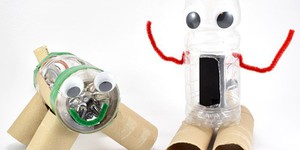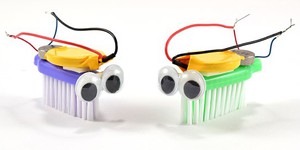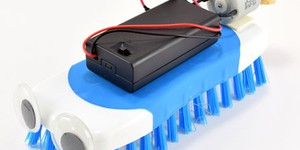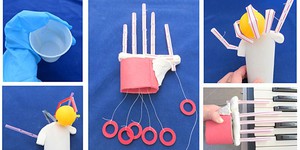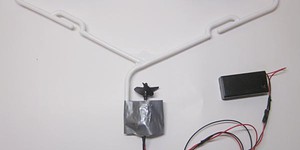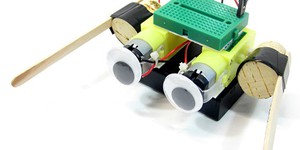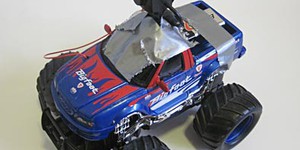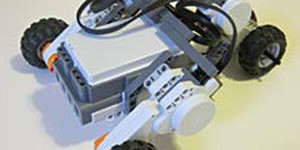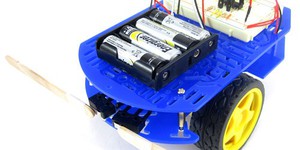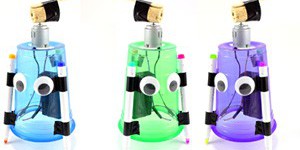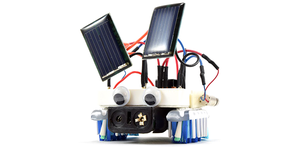Make a Robot
Explore the world of robotics by making a robot! Start with an easy robot, like a simple brushbot or an artbot, and work your way up to robots with more complex behaviors. Every robot in this collection has a clear list of materials you will need and easy-to-follow building instructions.
Building "junkbots" is a fun activity where you can turn recycled materials—like plastic bottles and cardboard tubes—into robots! This is a great activity for a classroom or a group of friends, because you can race your robots against each other and even make them sumo wrestle. You do not need any previous experience with robotics to build junkbots. A Science Buddies kit is available with all the electronic parts you need, including motors, batteries, and clear instructions for how…
Do you think you could build a robot on the head of a toothbrush? Bristlebots are simple, tiny robots that buzz around like bugs. They are easy to build and fun to play with, and you do not need any previous experience with robotics to make one. You can even build two bristlebots and race them against each other! Move on to the Materials section to see what parts you need to build bristlebots, and the instructions for step-by-step directions on how to build them.
Brushbots are a simple, fun type of robot that you can build out of arts and crafts materials. They are easy to build and you do not need any previous experience with robotics. You can build them yourself, build two robots with a friend and race them against each other, or even make them sumo wrestle! Go to the Materials section to see what parts you need to build a brushbot, and see the instructions for a step-by-step guide on how to build one.
Imagine how cool it would be to build a robot hand that could grasp a ball or pick up a toy. In this robotics engineering project, you will learn how to use drinking straws, sewing thread, and a little glue to make a remarkably lifelike and useful robot hand. What will you design your robot hand to do? Pick up a can? Move around a ping pong ball? It is up to you! With these starting instructions, you can design any type of hand. You will simulate human finger anatomy as the basis for a…
The world's oceans are home to the most strange and amazing creatures. What do scientists know about these deep-sea animals and how can they study them easily? One way to learn about these animals in their homes is to use underwater robots. Underwater robots can record data that would be difficult for humans to gather. But what are robots and how are they made? In this robotics engineering project, you will discover what makes up a simple robot and build and test your own underwater robot.
When you think about robots, chances are they are contraptions that you have seen on TV, in movies, or even in real life — and they are usually made of metal. What if you could make a soft robot that could bend, twist, or squirm like an octopus or an earthworm? Researchers at Harvard University have done exactly that, developing soft robots made of rubber and powered by air instead of electricity. In this project you will use their designs to build a soft robotic gripper of your own.
Have you ever seen a robot dance? In this project you will build your own simple flipping, tumbling robot that can dance around on the floor or a tabletop! If you have never made a robot before and would like to get started with a fun, easy project, this is a great place to begin. You will follow directions to make a basic robot, and then make your own additions to make it even better!
Have you ever heard of the NASA Mars rovers Spirit, Opportunity, Curiosity, and Perseverance? How about the "bomb squad" robots that police and the military use? These are places that are hard for us to reach (Mars), or dangerous for us to be near (explosives). Because the human operators are usually far away from the robot, driving one is different from driving a car. Operators rely on information sent back from the robot, including pictures and video. In this project, you will build your…
Light sensors are part of many devices that we use every day. For example, they help your phone know when to automatically brighten or dim the screen based on ambient light levels. They can also be used to help solar panels track the sun, which helps the panels generate more power. Many spacecraft and planetary rovers are solar-powered. In this project you will build and program your own solar-tracking robot. Optionally, you can add solar panels and rechargeable batteries. Can your robot keep…
Have you ever tried to ride your bike up a flight of stairs? Vehicles with wheels are great at traveling on paved roads or flat ground, but when it comes to stairs or uneven ground in the woods, wheels are not always such a great option. Inspired by real-life all-terrain robots, in this engineering project you will design and build a LEGO® robot that can travel over bumpy ground, through your yard, or even up a stack of textbooks — and almost anything else you can think of!
In the animal kingdom, many different critters use whiskers to help them find their way around in the dark, through murky waters, or even to help them hunt prey. Whiskers can be very useful when the animals cannot rely on sight. Did you know that you can also build a robot that uses "whiskers" to find its way around? This project will show you how to build a simple robot that uses whiskers as "bump sensors" to help the robot detect when it is about to bump into an obstacle, so it can turn…
Mechanical switches are common in many machines and robots. They can be used to detect when a button is pushed, when a door is open, or a low-speed collision when two objects bump into each other. Switches can act as "bump sensors" on a simple robot to help it detect when it hits an obstacle. The robot can use this information to navigate around obstacles and avoid getting stuck. Can you build and program a robot that can drive around your house while using bump sensors to avoid obstacles?
Do you like drawing or painting? What if you could build a robot that creates its own art? In this project, you will create your own Art Bot, a robot with markers for "legs" that wobbles across a piece of paper, creating drawings as it moves. You can then customize your robot to change how it draws. This is a beginner-level project with no robotics experience necessary, so if you want to try building your own robot, this is a great place to start!
You have probably heard about using renewable energy sources like wind and solar power to provide electricity to homes and buildings, as well as hybrid or fully electric cars that use less (or zero) gasoline. But what about solar-powered robots? As robots become more common, it is increasingly important to use "green" energy sources to power them. In this project, you will build and test a popular robot called a bristlebot — a tiny robot made using toothbrushes—that can operate on…
Sometimes engineers get ideas to build robots from animals in nature. There are robot dogs, robot snakes, robot birds, robot cheetahs, and even tiny robotic insects! In this science project, you will build a robot insect of your own. The robot will automatically drive toward a light source, mimicking a behavior called phototaxis, seen in some insects. You will build your own robot and then make adjustments so it can reliably drive toward a light.


